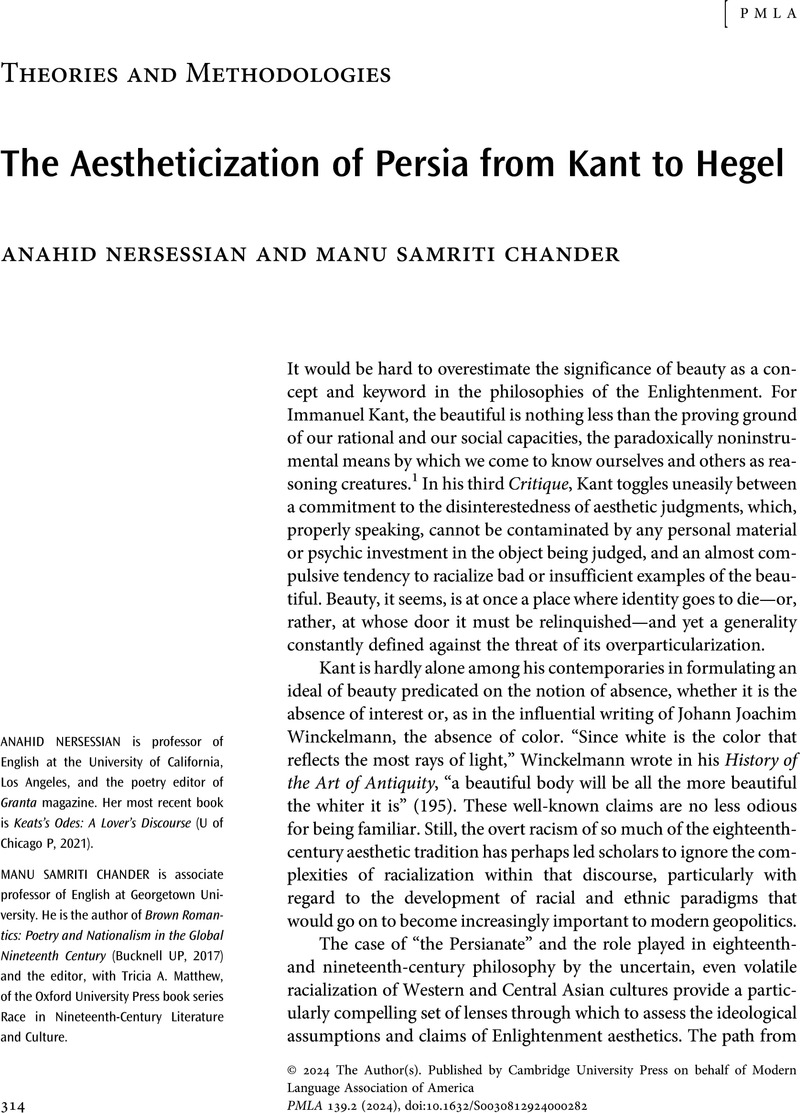No CrossRef data available.
Article contents
The Aestheticization of Persia from Kant to Hegel
Published online by Cambridge University Press: 26 July 2024
Abstract
An abstract is not available for this content so a preview has been provided. Please use the Get access link above for information on how to access this content.

- Type
- Theories and Methodologies
- Information
- Copyright
- Copyright © 2024 The Author(s). Published by Cambridge University Press on behalf of Modern Language Association of America
References
Works Cited
Adorno, Theodor. Aesthetic Theory. Translated by Hullot-Kentor, R., Athlone Press, 1977.Google Scholar
Arendt, Hannah. Lectures on Kant's Critical Philosophy. Translated by Beiner, Ronald, U of Chicago P, 1989.Google Scholar
Bendyshe, Thomas, editor. The Anthropological Treatises of Johann Friedrich Blumenbach, Late Professor at Göttingen and Court Physician to the King of Great Britain, with Memoirs of Him by Marx and Flourens, and an Account of His Anthropological Museum by Professor R. Wagner, and the Inaugural Dissertation of John Hunter, M.D. on the Varieties of Man. Longman, Roberts, and Green, 1865.Google Scholar
Blumenbach, Johann Friedrich. On the Natural Variety of Mankind. Bendyshe, pp. 69–325.Google Scholar
Dabashi, Hamid. Persophilia: Persian Culture on the Global Scene. Harvard UP, 2015.CrossRefGoogle Scholar
Green, Nile. “The Frontiers of the Persianate World (ca. 800–1900).” Introduction. The Persianate World: The Frontiers of a Eurasian Lingua Franca, edited by Green, U of California P, 2019, pp. 1–71.Google Scholar
Hegel, Georg Wilhelm Friedrich. Hegel's Aesthetics: Lectures on Fine Art. Translated by Knox, T. M., Clarendon Press, 1975. 2 vols.Google Scholar
Hegel, Georg Wilhelm Friedrich. The Philosophy of History. Translated by Sibree, J., Colonial Press, 1899.Google Scholar
Kant, Immanuel. Anthropology from a Pragmatic Point of View. Translated by Louden, Robert B., Zöller, and Louden, , pp. 227–429.Google Scholar
Kant, Immanuel. Gesammelte Schriften, Volume 15.2: Kant's Handschriftlicher Nachlass, Anthropologie (Zweite Hälfte). G. Reimer, 1913.Google Scholar
Kant, Immanuel. Observations on the Feeling of the Beautiful and the Sublime. Translated by Guyer, Paul, Zöller, and Louden, , pp. 18–62.Google Scholar
Kant, Immanuel. Of the Different Races of Human Beings. Translated by Wilson, Holly and Zöller, Günter, Zöller, and Louden, , pp. 82–97.Google Scholar
Kia, Mana. Persianate Selves: Memories of Place and Origin before Nationalism. Stanford UP, 2020.CrossRefGoogle Scholar
Lu-Adler, Huaping. Kant, Race, and Racism: Views from Somewhere. Oxford UP, 2023.CrossRefGoogle Scholar
Winckelmann, Johann Joachim. History of the Art of Antiquity. Translated by Malgrave, Harry Francis, Getty Research Institute, 2006.Google Scholar
Zöller, Günter, and Louden, Robert B., editors. The Cambridge Edition of the Works of Immanuel Kant: Anthropology, History, and Education. Cambridge UP, 2014.Google Scholar


